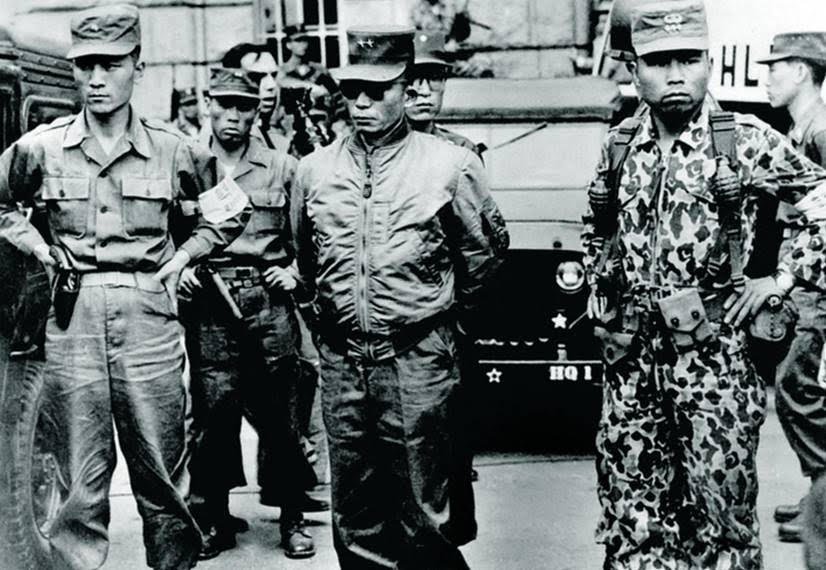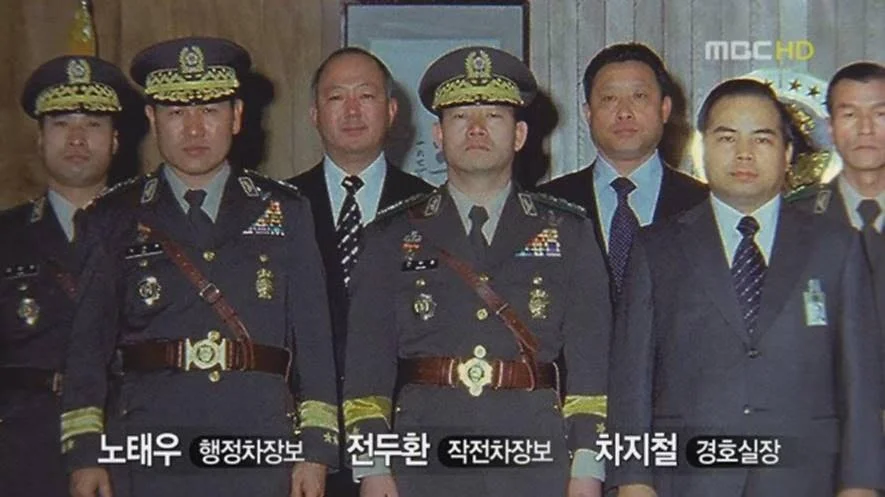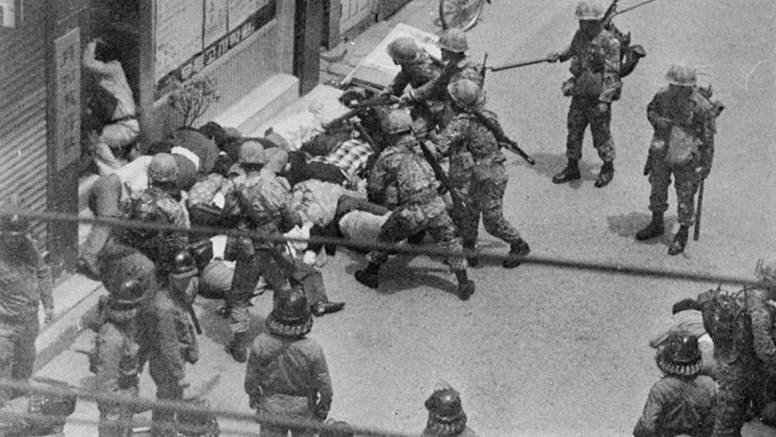[Pictured: The Azov Battalion, a Nazi paramilitary group that is part of Ukraine’s armed forces]
By Julien Charles
The immensely popular Swedish noir crime procedural novels by Lars Kepler are part of one of the more compelling series in Nordic crime fiction. In particular the Joona Lina series, in which police detectives track a Hannibal-esque serial killer who wreaks havoc on those he deems deserving. It only occurred to me late in the first novel that the killer is a Russian. Jurek Walter is an ex-soldier, remorselessly cynical, immune to pain, and a brutally efficient torturer and murderer of men and women alike. His feverishly demented goal is to ‘restore order’ by punishing those who have gotten away with a lot less criminal activity than murder. In short, an unimaginable psychopath of the kind that could only emerge from the ruins of the Soviet Union. The personification of evil.
The character in the novel embodied a version of Edward Said’s Orientalism, a process by which the West caricatures other regions, nations, and people in cartoonish and sophomoric ways. The better to understand them at a glance. Almost like a kind of intellectual shorthand by which to characterize and dismiss entire populations. Perform conceptual violence on them until they can be shunted into a shape that slides neatly into a western man’s conception of the world. Fits the Western cosmology, in which the U.S. and Europe shine as lodestars in a firmament of flickering blight. Everything in the heavens is of course in desperate need of guidance from the western polestar.
Examples of the dynamic of Orientalism are particularly rife in Hollywood. Countless series and movies have pitted pious Americans against a raft of crackpot Latinos, Slavs, Arabs, Persians, and Asians bent on genocide, world domination, and numberless other monomaniacal schemes. There’s of course no small amount of projection at work here in the fictional stylings of “the best minds of [our] generation”, as Ginsberg put it.
Not unlike the Kepler book, the Tom Cruise Jack Reacher films capitalize on the by now threadbare trope of a Soviet psychopath set loose in the naive and peaceable democracies of the West. The Zec is a man who escaped or survived the gulags in Siberia to wreak havoc on the West. In one scene, he describes how he once gnawed off a few fingers to avoid working in Siberian sulfur mines. A man of such exceptional capacities is no doubt useful to certain organizations, he muses. The Zec then encourages one of his low-level thugs to chew off his thumb as a show of fidelity, or some such deranged proof. The man—human, all too human—cannot do it and is summarily executed. The bloodless Zec then waxes psychopathic, wondering why westerners are so weak.
Observe the set pieces in the Jennifer Lawrence vehicle Red Sparrow. Scenes from the West are well-lit and overflowing with human emotion; scenes from behind the “iron curtain” are dimly lit, drab in color, stylistically old-world, barren of human empathy. In short, thoroughly depressing. Of course, as part of Lawrence’s character Dominika’s training in demolishing her human emotions (weaknesses all) and steeling herself in the arts of pitiless manipulation, she must appear naked before her class and satisfy the lust of a man who previously assaulted her.
Chronic Resentments
These are caricatures of Russians who evidently have been thoroughly dehumanized by life in the USSR. What has really dehumanized these characters is the propaganda which invented them.
Few events ignite this kind of Orientalism more than a war or proxy war with Russia, America’s bete noire. Despite the fact that the wall has been down for 30 years. Despite the fact that the West enjoyed an extended period of unrestrained looting in the Former Soviet Republics. During which time mortality rates skyrocketed for citizens of those fledgling states, thanks principally to the loss of the generous social supports that underpinned their Soviet economies. Despite the fact that Vladimir Putin is an avowed neoliberal who has repeatedly sought deeper integration with Europe and America, like a stepchild desperate to claim his birthright among a welter of siblings. Despite all this, Putin’s patriotic desire to reconstitute Russia as a viable economic and military power has damned him irreparably in the eyes of the West. He is like Kepler’s killer, the manifestation of undiluted evil. Except that Putin is real.
All this comes from a long lineage of Russophobia. It dates back to the Napoleonic Wars in Europe, which stirred fears of Russian plots to conquer Europe; to subsequent paranoia by British colonialists that Russia would steal the Indian subcontinent from its grasp; to the war to unseat the Bolsheviks and blistering responses to stories of mass slaughter under Soviet rule. In 1944, Hitler described Russians thusly, “These are not human beings: they are beasts from the Asiatic steppes, and the battle I am leading against them is the battle for the dignity of the people of Europe.” This view summarized the ideology behind Germany’s plan to murder 100 million Russians after the defeated the USSR. Likewise, we rarely hear that one of the small handful of groups energetically targeted for liquidation by the Nazis were communists. The Russians sacrificed 27 million people fighting off fascism. This loss is also infrequently highlighted.
The McCarthyite paranoia was a particularly acute instance of this chronic phobia. One can catch a whiff of the age-old bigotry in the propaganda of the present moment. The reflexive aggression toward Russia action in Ukraine (a recent article in The Times (UK) was entitled, “Russia’s casual savagery is seared into its soul”) This latest surge of bile seems in part an explosion of unresolved angst from the Russophobia of the Trump years, and perhaps a hundred years prior, though partially diffused by the fall of the wall. Yet it was still there even in the post-wall melees of capitalist looting under the doddering oversight of the Pushkin-quoting boozer Boris Yeltsin. Russians, Muscovites mostly, were freshly depicted as amoral, thieving mafiosi seduced by the flash of capital, the men brutal grotesques and the women biddable jades. Little was made of the valueless cosmos into which they’d been hurled by the blitzkrieg of capital on a society not remotely prepared for it.
(Much like the diagnosis of mental health in the West, problems of post-fall Russians were and are localized in the person, in the soul of a people, rarely traced to their societal causes. The New York Times just released a series on the “Inner Pandemic” of mental health issues, though it spends little time focusing on the circumstances that generated these crises, and which it enthusiastically supported.)
Even today one finds strains of the old Hitlerian trope coursing through the western mainstream. Recently on Germany’s ZDF channel, a guest of the Markus Lanz Show reminded viewers, with a slim smile, that, “Even if Russians look European, they are not European.” She rambled on incoherently about the Slavic view of death and noted that, “They have no concept of a liberal, post-modern life.” She may as well have said they were beasts from the Asiatic steppes and referred viewers to the Jack Reacher movie. After which, perhaps, they might donate to the latest national purity fund.
This seems to be part unhinged racism, but also a psychological necessity for enemies in nation-states. And one wonders if race isn’t utilized to that end. And whether this psychological need springs from a desire for national purpose, or more from an unrelenting need of capital for new markets—and the geospatial requirements that go with it. Surely the historical Lebensraum looms large behind modern geopolitical conflicts.
Addicted to Conflict
But it isn’t just the xenophobic fear of Slavic people. There’s another element at work here. One is reminded of Colin Powell, former leader of the Joint Chiefs of Staff—and dissembler nonpareil—before the U.N. Security Council. He once told a reporter that he feared he was “running out of enemies” in the aftermath of the fall of the Soviet Union. He was unwittingly disclosing a clandestine principle of Washington foreign policy. Namely, that it must always have an enemy. It cannot conceive a world of peaceful inhabitants, engaged in serene market exchange, celebrating a peace dividend while occasionally reminding new generations of the perils of conflict. This is not a conceit in the mental universe of the planners of American hegemony, be they retired generals on media networks, cabinet lieutenants sketching hemispheric takeovers, or well-compensated scriveners in beltway think tanks. And certainly not among the lurid corridors of K Street defense lobbyists. If Putin did not exist, Washington would have invented him. Much as they invented, to a surprising degree, Osama bin Laden and his Al Qaeda henchmen.
More often than not, the enemy must be cut from whole cloth. They do not ordinarily present themselves. Few countries are interested in going to war with the United States. At worst most nations are disinterested in submitting themselves to American rule, which manifests in numberless ways, a protean ogre extending its tentacles across the globe. Soft power, hard power, invisible power. Be it the petro dollar and the SWIFT system that places a subject nation under the perpetual threat of American sanctions. (A form of economic colonialism.) Be it bilateral security arrangements that infiltrate the country with U.S. military personnel and ensnare it in long-term weapons contracts with beltway defense contractors. (A form of military subjugation.) Be it onerous and odious loan agreements with Bretton Woods institutions that enslave generations of citizens to corrupt banks of the global North. (A form of vassalage.) From which those citizens’ meager avenues of escape include metastasizing debt service and consequent debt deflation, firesales of national patrimony, or the trauma of default, runaway inflation, and economic collapse. Choose wisely.
Rather than being enemies of the American state, such nations would really rather be left alone. To experiment with alternative economic models including socialism and its various hybrids. To trade in local currencies. To align in regional economic blocs. But this option–attempting to implement an economic structure other than western neoliberalism–is anathema to Washington. Just ask Russia, China, Iran, Venezuela, Brazil, Syria, Libya, North Korea, and any other nation that wishes to forge its own path.
The Real Enemy
Which brings us to the real enemy of the United States. Despite reports to the contrary, it is not fascism. Fascism is merely an end-point of capitalism, which will almost assuredly emerge wherever capitalism is practiced in unregulated and unrepentant fashion. As middle class wealth craters, however broadly, and extreme wealth and privilege expands, however narrowly, it will require force to generate compliance within a resentful and restive population. We are witnessing this transition in the West right now.
All this to say that, no, fascism was never the primary nemesis. The real enemy is communism. Western capital cannot abide the notion of a workers' state full of nationalized enterprises committed to the general welfare. One which deprioritizes the profit motive and tars it with the stigma of avarice and usury. This is and has always been Washington’s worst-case scenario, which it watched materialize in the Bolshevik Revolution, a knife in the side of capital that drew blood for 74 years, and which it tried hysterically to end all the while.
Not even the shameful scourge of Nazism rising up in the heart of civilized Europe was enough to lift fascism above communism as public enemy number one. As John Steppling notes in an excellent essay on the rehabilitation of fascism, Arthur Schweitzer, author of Big Business in the Third Reich, says that many German businessmen saw virulent anti-semitism as little more than a form of “economic policy reform.”
It is instructive to read works like The Splendid Blond Beast, which outlines the myriad deceptions of the postwar era of supposed deNazification in Western Europe. As it turns out, Washington was torn on the prosecution of Nazi war crimes. Although Frederick Roosevelt and others supported harsh punishment, helped establish Nuremberg and sent principled judges like Robert Jackson, others like powerful Director of Central Intelligence Allen Dulles and his Secretary of State brother John Foster Dulles sought to shield German industrialists and military officers, all deeply complicit and enthusiastic collaborators in the Nazi extermination campaigns.
Then there was Operation Paperclip, a full program dedicated to repatriating Nazis in the United States and installing them in key posts in pivotal internationalist institutions like the UN. And Nato’s alleged role in Operation Gladio, code name for a series of stay behind secret armies committed to armed resistance, acts of subversion, and terror, that were to be activated in the event of an invasion of Western Europe by Warsaw Pact nations, something never on the books in Moscow, but alive in the feverish imagination of beltway anti-communists. These dispersed embedded and hastily assembled paramilitaries were actually left behind to agitate against and prevent the rise of leftist (see communist) political blocs. They operated in Italy, Greece, France, Germany, Portugal and across Northern Europe. Nato, the CIA, and various European intelligence agencies were not about to watch Western Europe go communist regardless of what the democratized masses aberrantly desired.
Much of this history suggests that the underlying need of capitalism for new markets is primary, and perhaps that race is a tool leveraged to rationalize what is at bottom base exploitation. Hence our general acceptance of fascism in Ukraine and hysteria against Russia.
Selective Outrage
We might argue that this is different: Russia invaded another country. On investigation the argument falters, fractures amid a sea of sharp facts: a foreign backer, a coup d’etat, an ultranationalist takeover, a Nato infiltration, a legal apparatus mobilized against its own citizens, a massacre of ethnic Russians, preparations for a final assault. And finally, a full response from Moscow.
But even if an invasion were our threshold for outrage, none of this pathos has been evident in our response to the U.S.-backed Saudi war on Yemen, or U.S. wars on Libya and Syria. Even though the western aggression is criminal and death tolls are staggering. Even though there were plenty of visuals and myths available to rouse the choler of the people: visions of rampaging soldiers on Viagra rape sprees; grotesquely thin and lifeless children in the dust of the KSA’s induced famine; the hurling of gays off rooftops in Raqqa by ‘moderate rebels’. No, our collective consciousness has definitely been conditioned to despise most of all the legatees of Soviet communism, punished for the sins of the father in the first instance and for the defense of their national autonomy in the second. War, and war propaganda, is often a kind of industrialized hatred, organized malice armed with the implements of death.
As Arthur Ponsonby says in his book Falsehoods in War Time, deceitfulness is extraordinarily useful because humanity is mendacious and credulous in near equal measure. It lies and refuses to believe it is being lied to. Ponsonby, a member of British Parliament writing after World War I, says that nations must “justify themselves by depicting the enemy as an undiluted criminal; and secondly, to inflame popular passion for the continuance of the struggle.” Obviously little has changed since our initial experience of industrial warfare. We are constitutionally and economically committed to domineering aims, are inimical to anything that might impede our expansion, and we rationalize our behavior to these ends with a healthy dose of projection abetted by racist caricature. It is a frightful concoction of pitiless greed and base prejudice.
Yet every time we think we have put these cruel rancorous sides to our human selves to rest, they reappear, refashioned in new apparel, with fresh logic, ironclad rationales. We are sold a bill of goods. Perhaps this should come as no real surprise to citizens of a country that worships a single skill, salesmanship, and a single “virtue”, wealth, as its most sacred values. Everything is a commodity and everything that has been sold in the past will be sold again. Our entertainment culture is rife with reproductions of yesterday’s stories. Why not re-commoditize fascism? Wave the colors of a new flag and herald the insignia of a new battalion. Lionize a new leader, dress him in army green and pose him on the marble stairs of the halls of power, sandbags stacked to the roofs behind him. Honor under siege.
What has been sold before will be sold again; what we have hated before we will hate again. If it isn’t quite eternal return then it surely is history recurring as tragedy then farce. This soft embrace of fascism and rabid anti-communism goes all the way back to the Bolshevik uprising. As one of Kepler’s Nordic tales is subtitled, “Sometimes the past won’t stay buried.” Yes, the graves are always rather too near the surface.
Julien Charles is a concerned citizen hoping to call attention to the authoritarian drift of states across the Western world, and the disingenuous narratives promoted to gain consensus for such measures.


















